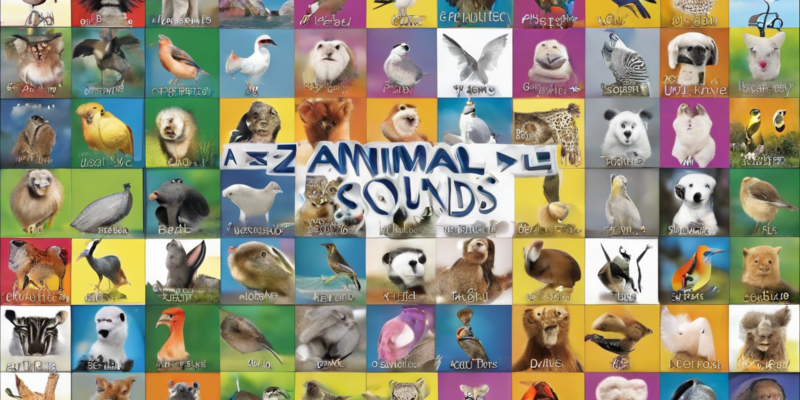Introduction
From the mighty roar of a lion to the gentle purring of a kitten, animal sounds captivate the imagination of children around the world. Learning about the sounds different animals make is not only fun but also educational, helping kids develop their auditory skills and understand the diversity of the animal kingdom. In this comprehensive guide, we will explore the A to Z of animal sounds, providing a complete list for kids to enjoy and learn from.
A – Z Animal Sounds List
A – Alligator: Hiss, grunts, and bellows
B – Bear: Roar, growl, and huff
C – Cat: Meow, purr, and hiss
D – Dog: Bark, woof, and growl
E – Elephant: Trumpet, rumbles, and roars
F – Frog: Croak, ribbit, and chirp
G – Gorilla: Grunt, hoot, and roar
H – Horse: Neigh, whinny, and snort
I – Insect: Buzz, chirp, and click
J – Jaguar: Roar, growl, and purr
K – Koala: Grunt, wail, and hiss
L – Lion: Roar, growl, and snarl
M – Monkey: Chatter, screech, and hoot
N – Nightingale: Sing, chirp, and trill
O – Owl: Hoot, screech, and hiss
P – Pig: Oink, snort, and grunt
Q – Quail: Call, whistle, and trill
R – Rooster: Crow, cackle, and cluck
S – Seal: Bark, growl, and grunt
T – Tiger: Roar, growl, and snarl
U – Uakari Monkey: Bark, grunt, and squeal
V – Vulture: Screech, hiss, and gobble
W – Wolf: Howl, growl, and whimper
X – Xerus: Chirrup, whistle, and bark
Y – Yak: Grunt, moo, and bellow
Z – Zebra: Neigh, whinny, and snort
Teaching with Animal Sounds
- Sound Matching Game: Create a fun game where kids match the animal with its corresponding sound. This activity promotes auditory discrimination and memory recall.
- Animal Sound Book: Make a personalized book with pictures of animals and their sounds. This interactive tool helps reinforce learning and can be a keepsake for years to come.
- Outdoor Scavenger Hunt: Take kids on a nature walk and listen for animal sounds. Encourage them to mimic the sounds they hear and identify the animals responsible.
- Music and Movement: Incorporate animal sounds into music and movement activities. Children can dance or move like the animals while making their sounds, enhancing creativity and kinesthetic learning.
Frequently Asked Questions (FAQs)
-
Can animal sounds vary by species?
Yes, animal sounds can vary greatly between species, even within the same animal family. Each animal has its unique way of communicating through sounds. -
Do animals only use sounds to communicate?
While sounds are a common form of communication among animals, they also use body language, scents, and visual cues to convey messages. -
Can animals understand each other’s sounds?
Animals are generally good at interpreting the sounds of their own species. Some animals can also recognize the sounds of other species, especially if they pose a threat. -
Do animals make sounds for reasons other than communication?
Yes, animals make sounds for various reasons, including mating calls, warning signals, expressing emotions, and establishing territories. -
Can animal sounds change over time?
Some animals can adapt their sounds based on environmental factors, social interactions, or learning from other animals. This ability helps them survive and thrive in their habitats. -
Why do some animals make loud sounds while others are quiet?
The volume of an animal’s sounds often depends on factors such as their size, habitat, social structure, and communication needs. Loud sounds can travel long distances or intimidate rivals, while quiet sounds may be used for close-range communication. -
Are there animals that are silent?
While most animals produce some form of sound, there are a few exceptions, such as certain species of snakes, insects, and marine creatures, that are known for their silence. -
Can humans mimic animal sounds accurately?
Humans have varying degrees of success in mimicking animal sounds. Some individuals, like professional wildlife imitators, can replicate sounds with astonishing accuracy, while others may struggle to achieve the same level of realism. -
Do baby animals make the same sounds as adults?
In many cases, baby animals mimic the sounds of adults but with slight variations. As they grow and develop, their vocalizations may change to better suit their needs as they mature. -
Are there animals that can mimic human sounds?
A few species, such as certain birds (parrots, mynas) and mammals (dolphins, elephants), have shown the ability to mimic human sounds to some extent. They often do so as part of their social interactions or for enrichment purposes in captivity.
Conclusion
Exploring animal sounds from A to Z opens up a world of wonder and learning for children. By listening to, imitating, and understanding these sounds, kids can develop a deeper appreciation for the richness and diversity of the animal kingdom. Incorporating animal sounds into play, education, and daily interactions can spark curiosity, creativity, and a sense of connection with the natural world. So next time you hear a roar, a chirp, or a howl, take a moment to pause, listen, and appreciate the symphony of sounds that surround us.



Comments